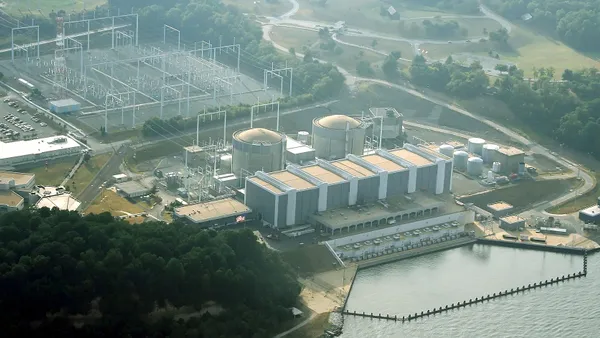Kevin Kamps is a radioactive waste specialist at Beyond Nuclear.
On March 8, Congress approved the FY24 Energy & Water appropriations bill, which contains massive subsidies for nuclear power and “strongly supports” developing “advanced” reactors and domestic uranium enrichment. This would have made Robert Oppenheimer cringe. He warned civilian nuclear power was inherently dangerous and proliferation-prone. But the industry has created an inaccurate narrative that nuclear is “clean” energy indispensable for fighting climate change, so federal and state governments should get behind it.
Despite clear evidence nuclear power makes climate change worse, get behind it they did. Massive taxpayer-funded bailouts for existing plants and untested “advanced” reactors are sailing through statehouses and Congress. Nuclear subsidies remained sacrosanct during the FY24 federal budget fight, even as conservatives demanded cuts in almost everything else.
The Price-Anderson Act, which indemnifies nuclear plant owners at public expense for potentially hundreds of billions of dollars per reactor disaster, expires next year, and the pending reauthorization is quietly advancing without any public hearings. It will expand indemnity for nuclear plant owners including coverage of so-called small modular reactors, or SMRs.
Price-Anderson and FY 24 appropriations bestow lavish federal largesse on SMRs even though they don’t yet exist — they're currently speculative design proposals, with only one SMR design certified so far by the Nuclear Regulatory Commission. SMRs lack safety standards, but that doesn't mean they would be safe. In addition, based on current designs, they are estimated to generate up to 30 times more radioactive waste per unit of electricity generated than exisitng conventional reactors. And if they ever do get built, SMRs won’t be remotely competitive with renewables. The nation’s first expected commercial SMR project was canceled last November due to significant cost increases.
U.S. nuclear regulation is notoriously lax. Owners demand and routinely get relief and exemption from Nuclear Regulatory Commission safety regulations, inspections, emergency planning and other requirements, while public watchdogs’ requests for regulatory enforcement are ignored.
The Obama-appointed NRC Commissioner Jeff Baran recently had his renomination quashed by pro-nuclear Congressional leaders, because as Sen. Joe Manchin, D-W. Va., said, he won’t support any nominee who’s too focused on safety. Now the House and Senate are negotiating a package to streamline NRC regulation and potentially change the agency’s mission from regulation to promotion — a half-century step backwards.
The lax regulatory environment is propelling unwelcome developments in the sector. Owners demand and get massive subsidies to keep aging, embrittled nuclear plants running, or, in the case of Palisades in Michigan, to restart an extremely dangerous reactor that was already permanently shutdown.
The privately held, unaccountably governed, firm Holtec bought the shuttered Palisades nuclear plant in 2022, supposedly to decommission it, but then a week later secretly applied for several billions of dollars in bailouts to restart it instead, causing the term “zombie nuke” to enter the lexicon. The NRC is treating the conversion of Holtec’s decommissioning license for Palisades to an operating license as a routine procedure, even though it’s unprecedented and Holtec has never operated a nuclear plant before.
Meanwhile, Holtec somehow spent $44 million of the Palisades Decommissioning Trust Fund, or DTF, in the first six months of its tenure doing little or no actual decommissioning work. In general, licensees spend hundreds of millions to billions in ratepayer-funded DTF money per reactor however they like, with next to no reporting requirements. The NRC no longer even pretends to monitor DTF spending, quietly admitting in a 2023 memo that “staff has ceased development of a procedure on how best to periodically assess trustee compliance and will terminate further assessment activities.”
Even as Holtec settled with the New Jersey attorney general over allegations it lied on its applications for state tax breaks, it came to light that the U.S. Department of Energy would give the company $1.5 billion in loan guarantees to restart Palisades, a down payment on many billions in federal and state taxpayer bailouts, as well as ratepayer overcharges, Holtec is also seeking for that purpose. Holtec is also requesting $7.4 billion in DOE loan guarantees for SMR new builds, including two at Palisades.
Restarting a shutdown reactor is reckless and sets a dangerous precedent for other closed plants. In FOIAed documents relating to Holtec’s Palisades bailout application, the company avowed that “one of the principal reasons Holtec has been acquiring aging nuclear plants is because such sites are near-perfect locations for building the SMR-160 reactors that the company has been developing.” Communities around decommissioning sites Holtec acquired, including New York’s Indian Point and Massachusetts’ Pilgrim, should beware of this agenda to renuclearize decommissioned sites with new SMRs of its own manufacture.
Today's misguided focus on nuclear power is diverting us from renewables, storage and efficiency, hobbling us in our race against climate chaos. Wasting large amounts of time and money on the false solution of nuclear power will not solve the climate crisis, and will aggravate nuclear risks.
Editor’s note: This op-ed has been updated with additional information about one SMR project's cost concerns.





















